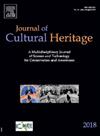Interplay between geological materials and the environment at the Dazu Rock Carvings, China
IF 3.3
2区 综合性期刊
0 ARCHAEOLOGY
引用次数: 0
Abstract
The study of the historical built environment is of great significance to the heritage conservation and the reconstruction of the level of anthropogenic pollution in the past. On the Dazu Rock Carvings, China, a black to reddish-brown, relatively dense mineral film with a thickness of approximately 150 μm was observed on the surface of the sandstone. The chemical composition of the mineral film studied by Scanning Electron Microscopy- Energy Dispersive Spectroscopy (SEM-EDS), Electron Probe Micro- Analyz (EPMA), X-ray Absorption Spectroscopy (XAS), Total Organic Carbon (TOC), and Ion Chromatography (IC), revealed that its development was comprehensively controlled by environmental conditions, especially by environmental pollution. The mineral film consisted primarily of clay minerals and iron oxide. It also contained a large amount of detrital quartz and feldspar, with a clear boundary with the underlying mineral matrix. The bacterial community was also investigated by next generation sequencing and its potential metabolisms through PICRUSt2. The mineral film on the surface of sandstone and its microbial community may provide a certain degree of protection for the internal structure. As a passive sampler, the variation of the concentration of pollution elements in the mineral film is helpful to understand the past environmental pollution of the city. Besides the relevance for stone heritage conservation, this study provides insights into the interplay between geological materials and the environment.
中国大足石刻中地质物质与环境的相互作用
研究历史建筑环境对遗产保护和重建过去的人为污染水平具有重要意义。在中国大足石刻上,在砂岩表面观察到一层厚度约为150 μm的黑色至红褐色相对致密的矿物膜。通过扫描电子显微镜-能谱(SEM-EDS)、电子探针-微观分析(EPMA)、x射线吸收光谱(XAS)、总有机碳(TOC)和离子色谱(IC)对矿物膜的化学成分进行了研究,发现其发育受环境条件,特别是环境污染的综合控制。矿物膜主要由粘土矿物和氧化铁组成。含大量石英和长石碎屑,与下伏矿物基质边界清晰。通过下一代测序和PICRUSt2对细菌群落及其潜在代谢进行了研究。砂岩表面的矿物膜及其微生物群落可能对内部结构提供一定程度的保护。作为被动采样器,矿物膜中污染元素浓度的变化有助于了解城市过去的环境污染情况。除了与石质遗产保护相关外,本研究还提供了地质物质与环境之间相互作用的见解。
本文章由计算机程序翻译,如有差异,请以英文原文为准。
求助全文
约1分钟内获得全文
求助全文
来源期刊

Journal of Cultural Heritage
综合性期刊-材料科学:综合
CiteScore
6.80
自引率
9.70%
发文量
166
审稿时长
52 days
期刊介绍:
The Journal of Cultural Heritage publishes original papers which comprise previously unpublished data and present innovative methods concerning all aspects of science and technology of cultural heritage as well as interpretation and theoretical issues related to preservation.
 求助内容:
求助内容: 应助结果提醒方式:
应助结果提醒方式:


